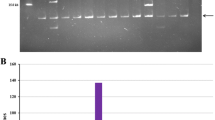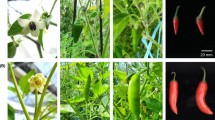Abstract
Spinach (Spinacae oleracae) is a nutritious vegetable and an economically important crop worldwide. Spinach is threatened by a number of diseases, and the most significant of which is downy mildew, caused by Peronospora farinosa f. sp. spinaciae (Pfs). The spinach locus RPF1 confers resistance to 11 of the 15 known races of Pfs. To study the RPF1 locus in depth, a BAC library was constructed from DNA of a single spinach plant that was homozygous at the RPF1 locus. The BAC library contained 73,728 clones, with an average insert size of 183 kb, which represented approximately 13 spinach genome equivalents (989 Mb). The ends of 1920 BAC clones were sequenced from both directions, and 3405 BAC end sequences (BESs) ranging from 100 to 935 bp were obtained. About 38.59 % of the BESs contained repetitive sequences, including 363 copies of retrotransposable elements and 32 copies of transposable elements. Less than 3 % of the clones originated from chloroplasts or mitochondria. Various categories of protein-encoding genes, including transcription factors, stress responsive genes, and reproduction-associated genes, were identified. Putative disease resistance genes containing nucleotide binding site-leucine-rich repeat (NBS-LRR) domains were also identified, one of which was closely linked to the RPF1 locus. Simple sequence repeat (SSR) motifs were identified from 154 BESs, including various di-, tri-, tetra-, and penta-nucleotide repeats. One hundred pairs of SSR primers and 24 retrotransposon primers were designed from BESs, all of which successfully amplified spinach DNA. This spinach BAC library will provide a useful resource for spinach genetic studies and breeding efforts.







Similar content being viewed by others
References
Allouis S et al (2003) Construction and characterisation of a hexaploid wheat (Triticum aestivum L.) BAC library from the reference germplasm ‘Chinese Spring’. Cereal Res Commun 31(3–4):331–338
Ariyadasa R, Stein N (2012) Advances in BAC-based physical mapping and map integration strategies in plants. J Biomed Biotechnol 2012:184854–184854
Arumuganathan K, Earle ED (1991) Nuclear DNA content of some important plant species. Plant Mol Biol Report 9:208–218
Bennetzen JL (2000) Transposable element contributions to plant gene and genome evolution. Plant Mol Biol 42:251–269
Bos L, Huijberts N (1996) Occurrence and transmission of sowbane mosaic virus in seed from naturally infected plants of spinach (Spinacia oleracea). Eur J Plant Pathol 102(7):707–711
Bos L et al (1980) Spinach latent virus, a new ilarvirus seed-borne in Spinacia oleracea. Neth J Plant Pathol 86(2):79–98
Chou HH, Holmes MH (2001) DNA sequence quality trimming and vector removal. Bioinformatics 17(12):1093–1104
Conesa A et al (2005) Blast2GO: a universal tool for annotation, visualization and analysis in functional genomics research. Bioinformatics 21(18):3674–3676
Correll JC et al (2007) Spinach downy mildew: overview of races and the development of molecular markers linked to major resistance genes. In: Lebeda A, Spencer-Philips PTN (ed) Advances in downy mildew research Vol. 3. Olomouc, The Czech Republic, pp 135–142
Correll JC et al (2011) Spinach: better management of downy mildew and white rust through genomics. Eur J Plant Pathol 129(2):193–205
Dicoteau DR (2000) Vegetable crops. Prentice Hall, New Jersey
Du Toit LJ et al (2007) Cucumber mosaic virus and beet western yellows virus in spinach seed crops in the Pacific Northwest, USA. Phytopathology 97(7):S30–S30
Ellis J et al (2000) Structure, function and evolution of plant disease resistance genes. Curr Opin Plant Biol 3(4):278–284
Ewing B, Green P (1998) Base-calling of automated sequencer traces using phred. II. Error probabilities. Genome Res 8(3):186–194
Ewing B et al (1998) Base-calling of automated sequencer traces using phred. I. Accuracy assessment. Genome Res 8(3):175–185
Feng C et al (2014) Identification of new races and deviating strains of the spinach downy mildew pathogen Peronospora farinosa f. sp spinaciae. Plant Dis 98(1):145–152
Gratsia ME et al (2012) First report of Olive mild mosaic virus and Sowbane mosaic virus in spinach in Greece. Plant Dis 96(8):1230–1230
Groben R, Wricke G (1998) Occurrence of microsatellites in spinach sequences from computer databases and development of polymorphic SSR markers. Plant Breed 117(3):271–274
Hagihara E et al (2005) Sugar beet BAC library construction and assembly of a contig spanning Rf1, a restorer-of-fertility gene for Owen cytoplasmic male sterility. Mol Gen Genomics 274(3):316–323
Hu J et al (2007) Genetic diversity of 38 spinach (Spinacia oleracea L.) germplasm accessions and 10 commercial hybrids assessed by TRAP markers. Genet Resour Crop Evol 54(8):1667–1674
Irish BM et al (2003) Identification and cultivar reaction to three new races of the spinach downy mildew pathogen from the United States and Europe. Plant Dis 87(5):567–572
Irish BM et al (2007) Three new races of the spinach downy mildew pathogen identified by a modified set of spinach differentials. Plant Dis 91(11):1392–1396
Irish BM et al (2008) Characterization of a resistance locus (Pfs-1) to the spinach downy mildew pathogen (Peronospora farinosa f. sp spinaciae) and development of a molecular marker linked to Pfs-1. Phytopathology 98(8):894–900
Ito M et al (2000) Characterization of spinach chromosomes by condensation patterns and physical mapping of 5S and 45S rDNAs by FISH. J Am Soc Hortic Sci 125(1):59–62
Kalendar R, Schulman AH (2006) IRAP and REMAP for retrotransposon-based genotyping and fingerprinting. Nat Protoc 1(5):2478–2484
Kalendar R, Schulman AH (2014) Transposon based tagging: IRAP, REMAP, and iPBS. In: Besse P (ed) Molecular Plant Taxonomy: Methods and Protocols. Springer, New York, pp 233–255
Kalendar R et al (1999) IRAP and REMAP: two new retrotransposon-based DNA fingerprinting techniques. Theor Appl Genet 98(5):704–711
Kaye C et al (1998) Characterization of a gene for spinach CAP160 and expression of two spinach cold-acclimation proteins in tobacco. Plant Physiol 116(4):1367–1377
Khattak JZK et al (2006) A genetic linkage map of Spinacia oleracea and localization of a sex determination locus. Euphytica 148:311–318
Khattak JZK et al (2007) Genic microsatellite markers for discrimination of spinach cultivars. Plant Breed 126(4):454–456
Krapp A, Stitt M (1995) An evaluation of direct and indirect mechanisms for the sink-regulation of photosynthesis in spinach—changes in gas-exchange, carbohydrates, metabolites, enzyme-activities and steady-state transcript levels after cold-girdling source leaves. Planta 195(3):313–323
Kubicki B (1982) Determination of sex and type of growth in spinach (Spinacia oleracea L.). Genetica Pol 23(4):195–207
Lijavetzky D et al (1999) Construction and characterization of a bacterial artificial chromosome (BAC) library for the A genome of wheat. Genome 42(6):1176–1182
Liu HY et al (2010) First report of beet necrotic yellow vein virus infecting spinach in California. Plant Dis 94(5):640–640
Luo M, Wing RA (2003) An improved method for plant BAC library construction. Methods Mol Biol (Clifton, NJ) 236:3–20
Martin SL et al (2002) MagnaportheDB: a federated solution for integrating physical and genetic map data with BAC end derived sequences for the rice blast fungus Magnaporthe grisea. Nucleic Acids Res 30(1):121–124
Martins WS et al (2009) WebSat—a web software for microsatellite marker development. Bioinformation 3(6):282–283
McGrath JM et al (2004) Construction of a sugar beet BAC library from a hybrid with diverse traits. Plant Mol Biol Report 22(1):23–28
Meyers BC et al (2001) Abundance, distribution, and transcriptional activity of repetitive elements in the maize genome. Genome Res 11(10):1660–1676
Morelock TE, Correll JC (2008) Spinach breeding. In: Prohens J, Nuez F (ed) Handbook of plant breeding vegetable I. Springer, New York, pp. 183–212
O’Sullivan DM et al (2001) A maize bacterial artificial chromosome (BAC) library from the European flint inbred lined F2. Theor Appl Genet 103(2–3):425–432
Salimath SS, Bhattacharyya MK (1999) Generation of a soybean BAC library, and identification of DNA sequences tightly linked to the Rps1-k disease resistance gene. Theor Appl Genet 98(5):712–720
Sambrook J et al (1989) Molecular cloning: a laboratory manual. Cold Spring Harbor Laboratory, New York
Sanmiguel P, Bennetzen JL (1998) Evidence that a recent increase in maize genome size was caused by the massive amplification of intergene retrotransposons. Ann Bot 82:37–44
Schmitz-Linneweber C et al (2001) The plastid chromosome of spinach (Spinacia oleracea): complete nucleotide sequence and gene organization. Plant Mol Biol 45(3):307–315
Scott NS, Timmis JN (1984) Homologies between nuclear and plastid DNA in spinach. Theor Appl Genet 67(2–3):279–288
Stern DB, Palmer JD (1986) Tripartite mitochondrial genome of spinach: physical structure, mitochondrial gene mapping, and locations of transposed chloroplast DNA sequences. Nucleic Acids Res 14(14):5651–5666
Stevens MR et al (2006) Construction of a quinoa (Chenopodium quinoa Willd.) BAC library and its use in identifying genes encoding seed storage proteins. Theor Appl Genet 112(8):1593–1600
Sutic DD et al (1999) Handbook of plant virus diseases. CRC, Boca Raton
Tao Q et al (2002) One large-insert plant-transformation-competent BIBAC library and three BAC libraries of Japonica rice for genome research in rice and other grasses. Theor Appl Genet 105(6–7):1058–1066
Timmis JN, Scott NS (1983) Sequence homology between spinach nuclear and chloroplast genomes. Nature 305(5929):65–67
Tomkins JP et al (2001) Development of genomic resources for cotton (Gossypium hirsutum L.): BAC library construction, preliminary STC analysis, and identification of clones associated with fiber development. Mol Breed 8(3):255–261
Whisson DL, Scott NS (1985) Nuclear and mitochondrial-DNA have sequence homology with a chloroplast gene. Plant Mol Biol 4(5):267–273
Xia ZJ et al (2005) Construction and characterization of a BAC library of soybean. Euphytica 141(1–2):129–137
Zhang HB, Wu CC (2001) BAC as tools for genome sequencing. Plant Physiology and Biochemistry 39(3–4):195–209
Acknowledgments
The authors would like to thank Drs. Rod Wing and Dave Kudrna for their assistance with the construction of the BAC library. Partial support for the library construction was provided by a consortium of spinach seed companies under the administrative organization of Plantum, the Netherlands.
Author information
Authors and Affiliations
Corresponding author
Electronic supplementary material
Below is the link to the electronic supplementary material.
Supplementary Table 1
(DOCX 13 kb)
Supplementary Table 2
(DOCX 12 kb)
Supplementary Table 3
(DOCX 12 kb)
Rights and permissions
About this article
Cite this article
Feng, C., Bluhm, B.H. & Correll, J.C. Construction of a Spinach Bacterial Artificial Chromosome (BAC) Library as a Resource for Gene Identification and Marker Development. Plant Mol Biol Rep 33, 1996–2005 (2015). https://doi.org/10.1007/s11105-015-0891-9
Published:
Issue Date:
DOI: https://doi.org/10.1007/s11105-015-0891-9




